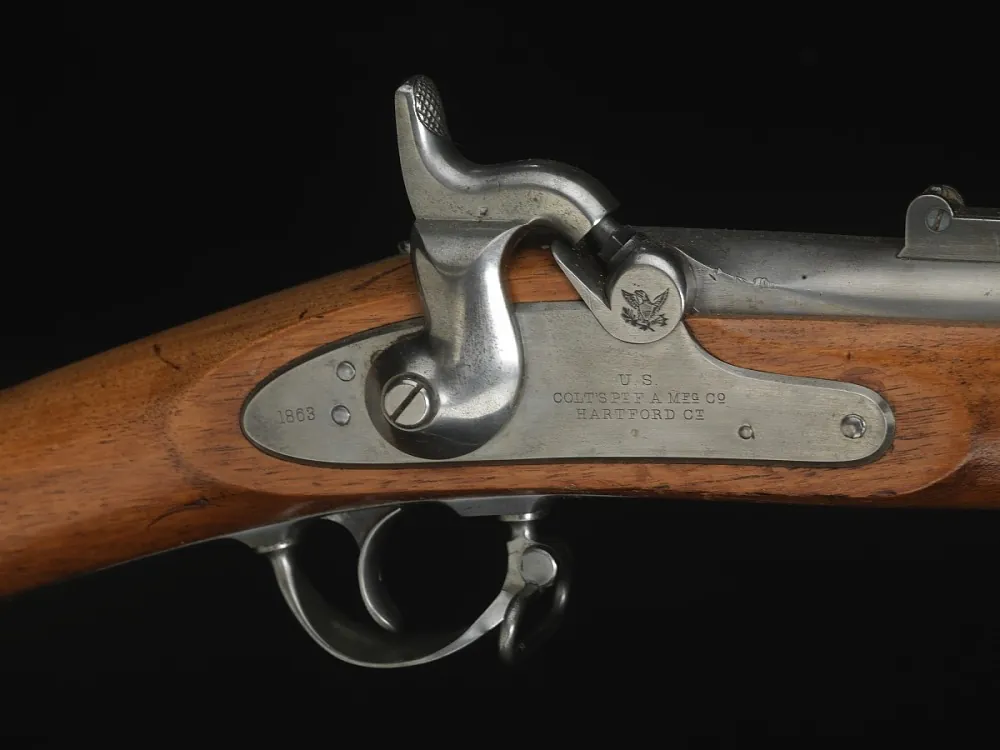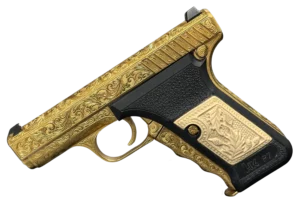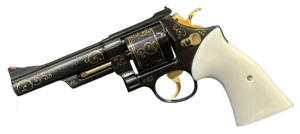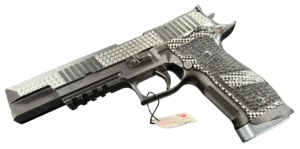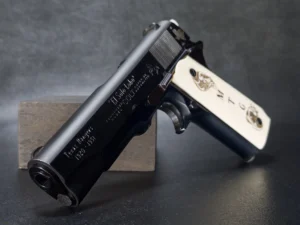Key Takeaways:
- Rifles Didn’t Just Evolve—They Transformed the Way Wars Were Fought: From the smoke-belching Brown Bess to the semi-auto punch of the M1 Garand, rifles pushed battlefield tactics into entirely new eras. Each leap in design—rifling, breech-loading, rapid-fire mechanics—wasn’t just technical; it was tactical. The weapons shaped the strategies, not the other way around.
- These Firearms Aren’t Just Guns—They’re Time Capsules: Every old rifle has a story. Whether it sat in the mud at Antietam or clacked through the Russian frost at Stalingrad, these aren’t just pieces of steel and walnut. They carry the fingerprints of history—of real people, real moments, and real change. To hold one is to feel a spark from the past.
- Collecting Old Rifles Is About Respect as Much as Rarity: Sure, it’s thrilling to chase a rare Winchester or an all-matching Mauser. But thoughtful collecting goes deeper. It’s about honoring the stories, verifying provenance, and preserving legacy, not just padding a display case. A collector isn’t just someone who buys old rifles—they’re someone who listens to what those rifles still have to say.
Some weapons don’t just win battles—they reshape civilizations. And rifles? They’ve done that and more. From the thunderous chaos of early muskets to the smooth mechanics of bolt-action legends and the rapid efficiency of semi-autos, the evolution of rifles has gone hand in hand with the evolution of warfare itself.
Here’s the thing: rifles aren’t just cold metal and wood. They’re relics of ingenuity, necessity, and sometimes desperation. Every nick in the stock or notch in the barrel tells a story—of soldiers in muddy trenches, of skirmishes in forests, of revolutions won and lost. When we talk about old rifles, we’re talking about history in its most visceral form.
From Firesticks to Firepower: The Evolution of the Rifle
Back before bullets flew with purpose, there were muskets—long, cumbersome things that were more likely to intimidate than actually hit anything. Firing one was like trying to throw a baseball blindfolded. But they were loud, they were scary, and in the early days of warfare, that counted for something.
The Brown Bess, for example, wasn’t built for sharpshooters. It was meant for volley fire—hundreds of redcoats letting loose in synchronized chaos. And then came rifling, a seemingly small tweak that changed everything. By cutting spiral grooves into the barrel, bullets spun as they left the gun. The result? Accuracy. And with that, warfare started to look very different.
And so began the era of meaningful upgrades:
- Flintlocks overtook matchlocks—less fuss, more fire
- Percussion caps brought quicker, cleaner ignition
- Breech-loading rifles made loading faster and safer
- Lever-actions and repeaters, like the legendary Winchester, revolutionized how fast soldiers could shoot
The Industrial Revolution turned gunsmithing from a craft into an industry. Suddenly, armies weren’t just better equipped—they were consistently equipped. And by the 20th century, rifles like the M1 Garand made semi-automatic fire a standard reality. That meant a single soldier could lay down sustained fire without fiddling with powder and ramrods.
But to get there, we had to start with the basics. Let’s walk through some of the rifles that paved the way.
The Brown Bess: Backbone of British Domination
The Brown Bess wasn’t sleek or subtle. It was a beast. Heavy, long, and loud, it was standard issue for British infantry for more than a century. And during that time, it played a starring role in some of the most critical battles of the empire.
Its job wasn’t to hit a specific target—it was to fill the air with terror. A synchronized volley from a line of soldiers carrying Brown Bess muskets was deafening, smoky, and deadly in its own way. Add a bayonet, and you have a spear with gunpowder backup.
Places it left its mark:
- The American Revolutionary War
- The Napoleonic Wars
- Colonial skirmishes and rebellions
- The War of 1812
It had a .75 caliber smoothbore barrel, a flintlock mechanism, and a look that screamed “this will hurt.” Was it accurate? Not even close. But in its day, that didn’t matter. Tactics were built around its limitations—and its strengths.
Collectors today see it as a symbol of an empire’s might and a chapter in the slow march toward modern firearms. Owning one isn’t just about the gun—it’s about holding a piece of 18th-century battlefield philosophy.
The Kentucky Rifle: The Sharpshooter’s Secret Weapon
In a forest ambush, precision beats noise. And that’s where the Kentucky Rifle came in. Crafted with love and skill, mostly by German-American gunsmiths, it was leaner, lighter, and longer-ranged than any musket of its time.
Its rifled barrel made it deadly accurate—perfect for backwoods skirmishes, hit-and-run tactics, and the kind of warfare the Redcoats weren’t ready for. These weren’t weapons of mass fire—they were sniper tools before snipers were a thing.
Why it mattered:
- Rifling meant better accuracy at a distance
- Often custom-made, with elegant designs and engravings
- Perfect for rugged terrain and guerrilla tactics
This wasn’t a military-issued gun; it was a frontier necessity. Carried by pioneers and militia, the Kentucky Rifle helped shape early American identity, not just in war, but in the myth of the self-reliant rifleman.
Collectors today value these rifles for their craftsmanship. Each one is a little different. And each one tells a story not just of war, but of artisanship and individuality.
Springfield Model 1861: The Civil War’s Workhorse
When the American Civil War erupted, the Springfield Model 1861 was there to meet the moment. With more than a million produced, it was the most commonly used rifle of the war, and a dramatic step forward in battlefield firepower.
What set it apart? Rifling and the Minie ball. That deadly pairing meant soldiers could fire accurately from longer distances with more stopping power. The rifle was also reliable in harsh conditions, from muddy fields to freezing camps.
Standout features:
- .58 caliber with a rifled barrel
- Effective up to 500 yards
- Bayonet-compatible
- Often used with paper cartridges
This wasn’t just a weapon; it was a turning point. Battles became longer and bloodier because soldiers could shoot further and hit harder. Military strategy had to evolve fast, and the Springfield was at the heart of that transformation.
Today, it’s one of the most collected Civil War rifles. And for good reason. Owning one is like holding a page torn straight from American history.
Winchester Model 1873: The Wild West’s Best Friend
No rifle screams “Old West” quite like the Winchester 1873. This lever-action legend wasn’t just a gun—it was a lifeline. Whether you were defending your homestead or robbing a train (not recommended), the Winchester was the go-to.
Its biggest selling point? Speed. That lever-action system allowed for quick follow-up shots, which could make all the difference in a shootout—or a standoff with a grizzly.
What made it special:
- Chambered in .44-40 (also used in Colt revolvers)
- 15-round capacity
- Rugged enough for harsh conditions
- Favored by lawmen, outlaws, and ranchers
It’s been immortalized in film, folklore, and firearms history. Today, the Winchester 1873 is a staple in collections. And not just because of its performance, but because it captures the spirit of a time when survival often depended on a quick trigger and a steady aim.
Mauser Model 1898: The Bolt-Action Blueprint
Ask any military historian what changed rifle warfare forever, and they’ll probably say: the Mauser. Specifically, the Model 1898. This German innovation set a new gold standard for bolt-action rifles and influenced countless designs after it.
Why it ruled:
- Controlled-feed bolt-action system
- Five-round internal magazine
- Chambered in 7.92x57mm
- Rugged steel and wood construction
The Mauser was efficient, powerful, and adaptable. It saw combat in two World Wars and became the foundation for rifles like the U.S. M1903 Springfield. Even decades later, hunters and snipers have sought it out for its accuracy.
If you’re building a collection, having a Mauser is like owning a blueprint. It’s not just a piece of the puzzle—it’s the piece that shaped the rest.
Lee-Enfield: The Empire’s Lightning Bolt
Fast, accurate, and tough—the Lee-Enfield was everything the British military needed and more. Introduced in the late 1800s, it served through WWI, WWII, and beyond. Its claim to fame? The fastest manual bolt-action cycle in the world.
British soldiers were trained to fire 15 aimed shots per minute. And the rifle held up under the pressure. Mud, rain, sand—it didn’t matter.
Core highlights:
- 10-round magazine (twice as many as most contemporaries)
- .303 British caliber
- Used in dozens of countries and colonial conflicts
Whether in the trenches or jungles, the Lee-Enfield performed. And collectors love it today for the same reasons soldiers did back then: it works. Really well.
Mosin-Nagant: The Russian Workhorse
Built like a tank and just as dependable, the Mosin-Nagant is Russia’s most iconic rifle. First issued in the 1890s, it saw combat in World Wars, civil wars, and revolutions. It was a staple of the Soviet Red Army and remained in service long after other rifles were retired.
Why it endured:
- Simple bolt-action design
- 5-round internal magazine
- Chambered in 7.62x54R
- Resistant to extreme cold and battlefield abuse
Sniper versions with PU scopes gained fame in WWII. Vasily Zaitsev’s Mosin turned him into a legend at Stalingrad. And today, surplus Mosins are still floating around, offering a budget-friendly way into historic rifle collecting.
M1 Garand: The American Powerhouse
When U.S. troops stormed the beaches of Normandy, many of them carried the M1 Garand. This semi-automatic rifle changed the battlefield calculus. No longer did soldiers have to reload after every shot—they could keep firing until their 8-round clip pinged out with a distinctive “ting.”
Why it mattered:
- Semi-automatic action = faster shooting
- .30-06 Springfield chambering = power and range
- Gas-operated cycling = less recoil fatigue
It wasn’t just loved by the troops; it was respected by enemies. The M1 Garand gave the Allies a real edge. Today, it remains a favorite among collectors, history buffs, and competitive shooters.
AK-47: The People’s Rifle
Designed by Mikhail Kalashnikov, the AK-47 redefined what a military rifle could be. Cheap, easy to use, and devilishly reliable, it became the weapon of choice for revolutionaries, militias, and armies across the globe.
Key traits:
- Selective fire (semi and full auto)
- 7.62x39mm round
- Loose tolerances = flawless operation in dirt, mud, and worse
It’s the most produced firearm in the world, and it shows up everywhere—from civil wars in Africa to propaganda posters. It’s iconic, infamous, and undeniably effective.
So You Wanna Collect? Let’s Talk Strategy
Diving into old rifle collecting is like becoming a historian with a toolbox. You’re not just buying guns—you’re preserving stories. But don’t rush in.
Get educated first. Learn to spot reproductions, mismatched parts, and too-good-to-be-true deals. Understand what markings mean, and which versions are rarest.
Tips for beginners:
- Always ask for serials and provenance
- Beware of “cleaned up” rifles—they may look pretty but lose value
- Join collector forums and local clubs
The more you learn, the better your eye gets. And the more stories you’ll have to tell.
Buying and Selling Without the Headache
It’s easier than ever to buy or sell antique rifles—but it’s also easy to get burned. Stick to well-known sites like GunBroker, Rock Island Auction, or Legacy Collectibles. Read seller reviews. Ask for extra photos.
Good places to look:
- Reputable online auction platforms
- Antique firearms expos
- Estate sales with firearms listings
- Local dealer networks
And always—always—know your local laws. Some states treat 100-year-old rifles the same as modern assault weapons. Do your homework.
Ethics, Provenance, and the Responsibility of Memory
Every antique rifle was carried by someone. Maybe it was a farmer defending his land. Maybe it was a conscript caught in a war he didn’t choose. Respect that.
Stick to legal, ethical sellers. Avoid “graveyard guns” or anything with a shady backstory. And when you display or discuss your collection, honor the people and the history behind it.
Caring for History: How to Preserve Your Rifles
Good care means these old guns can last another hundred years. So don’t skimp.
What to do:
- Use only gun-safe oils and materials
- Keep them in climate-controlled storage
- Handle them with gloves or freshly washed hands
- Avoid over-cleaning—patina is part of the charm
A well-cared-for rifle tells a better story. Think of yourself as its caretaker, not just its owner.
Final Shots: Echoes From the Past
Old rifles are echoes. They hum with memory. With every bolt cycle or trigger pull, you’re brushing up against lives once lived, battles once fought, and histories still unfolding.
Whether you’re preserving them behind glass or taking them to the range, these rifles offer something profound—a physical, weighty reminder of who we were and how far we’ve come.
So the next time you pick up one of these beauties, take a second. Listen. That creak in the wood? That whisper of oil and steel? That’s history talking back.
And you just became part of the conversation.
Frequently Asked Questions
Because they’re more than just old metal—they’re living history. Each one tells a story, not just about a war or a battle, but about the people who fought, the technology of the time, and the values of the era. Studying or collecting them gives you a hands-on connection to the past that no textbook can match.
That depends on the rifle, its condition, and whether it’s been adequately maintained. Some old rifles can still shoot accurately, especially bolt-action models like the Mosin-Nagant or Mauser 1898. But here’s the catch: never assume. Always have a qualified gunsmith inspect it first. Firing an unchecked antique is like driving a century-old car at freeway speeds—you might be fine, or you might blow a gasket.
A musket is smoothbore—no rifling inside the barrel—so it’s less accurate. Muskets were designed for volley fire, not precision. Rifles, on the other hand, have grooves (rifling) that make the bullet spin, improving range and accuracy. Once rifling became common, military tactics had to evolve fast.
Great question—and one that trips up a lot of new collectors. Look for details: serial numbers, proof marks, original manufacturer stamps, and wear patterns consistent with age. Reproductions often look too clean or use modern screws and finishes. Research the specific model, and when in doubt, consult other collectors or a reputable dealer.
Yes… and no. In the U.S., federal law generally doesn’t regulate pre-1899 firearms as firearms. That means they can be bought and sold without an FFL in most cases. But state and local laws vary wildly. And if the rifle has been modernized or uses ammunition still in production, it might be classified differently. Always check your local regulations before making a move.


